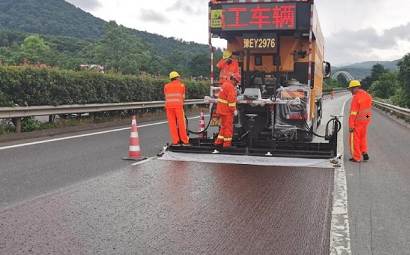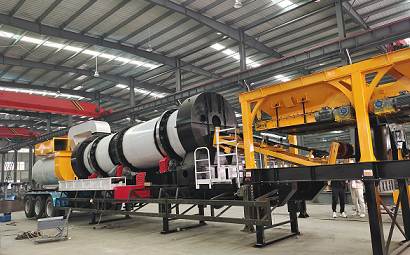1. Technical preparation before construction
Before construction of the slurry sealing truck, the oil pump, water pump system and oil (emulsion) and water pipelines on the machine should be checked to see if there are any faults in the control valves; start and stop tests should be carried out on each part of the machine to check whether the operation is Normal; for sealing machines with automatic control functions, use automatic control to operate the air transport; to check the sequential linkage between various components; after the overall machine operation is normal, the feeding system on the machine must be calibrated. The calibration method is: fix the output speed of the engine, adjust the opening of each material door or valve, and obtain the discharge volume of various materials at different openings per unit time; based on the mixture ratio obtained from the indoor test, Find the corresponding material door opening on the calibration curve, and then adjust and fix the opening of each material door to ensure that materials can be supplied according to this ratio during construction.
2. Operations during construction
First drive the slurry sealing truck to the starting point of the paving construction, and adjust the guide sprocket in front of the machine to align it with the direction control line of the machine. Adjust the paving trough to the required width and hang it on the machine. The position of the tail paving groove and the tail of the machine must be kept parallel; confirm the output scale of various materials on the machine; detach each transmission clutch on the machine, then start the engine and allow it to reach normal speed, then engage the engine clutch and start the clutch drive shaft; Engage the conveyor belt clutch, and quickly open the water valve and emulsion valve at the same time, so that the aggregate, emulsion, water and cement, etc., enter the mixing drum in proportion at the same time (if an automatic control operating system is used, you only need to press a button, and all the materials will be activated after startup. The materials can then enter the mixing drum according to the designed discharge amount at the same time); When the slurry mixture in the mixing drum reaches half the volume, open the outlet of the mixing drum to allow the mixture to flow into the paving tank; at this time, you must carefully observe the consistency of the slurry mixture and adjust the water supply to make the slurry The mixture reaches the required consistency; when the slurry mixture fills 2/3 of the paving tank, start the machine to pave evenly, and at the same time open the water spray pipe at the bottom of the sealing machine to spray water to wet the road surface; when If one of the spare materials on the sealing machine is used up, you should immediately disengage the conveyor belt clutch, open and close the emulsion valve and water valve, and wait until all the slurry mixture in the mixing drum and paving tank has been paved, and the machine That is to say, it stops moving forward, and then re-loads materials for paving after cleaning.


3. Precautions for operating the slurry sealing truck
① After starting the diesel engine on the chassis, it should be run at medium speed to maintain the uniformity of the paving speed.
② After the machine is started, when the clutches of the aggregate and belt conveyor are connected to put the aggregate conveyor into working condition, the waterway ball valve must be opened when the aggregate begins to enter the mixing drum, and the emulsion three-way valve must be turned after waiting for about 5 seconds. , spray the emulsion into the mixing tube.
③When the amount of slurry reaches about 1/3 of the capacity of the mixing cylinder, open the slurry discharge door and adjust the height of the mixing cylinder discharge door. The amount in the lotion cartridge should be kept at 1/3 of the cartridge capacity.
④ Observe the consistency of the slurry mixture at any time, and adjust the amount of water and emulsion in time.
⑤According to the remaining slurry in the left and right paving troughs, adjust the inclination angle of the distributing trough; adjust the left and right screw propellers to quickly push the slurry to both sides.
⑥ Control the speed of the upper part of the machine. During machine operation, it should be able to maintain 2/3 of the slurry capacity in the paving trough to ensure the continuity of the paving trough operation.
⑦ During the interval between each truck of materials being paved and reloaded, the paving trough must be removed and moved to the roadside for flushing with water spray.
⑧After the construction is completed, all main switches should be turned off and the paver box should be raised so that the machine can easily drive to the cleaning site; then use high-pressure water on the paver to flush the mixing drum and paver box, especially for the paver box. The rubber scraper at the back must be rinsed clean; the emulsion delivery pump and delivery pipeline should be rinsed with water first, and then diesel fuel should be injected into the emulsion pump.
4. Maintenance when the machine is parked for a long time
① Routine maintenance should be carried out on the chassis engine and working engine of the machine in accordance with the relevant provisions in the engine manual; the hydraulic system should also be maintained on a daily basis in accordance with the relevant provisions.
② Use a diesel cleaning gun to spray clean parts such as mixers and pavers that are stained with emulsion, and wipe them with cotton gauze; the emulsion in the emulsion delivery system should be completely drained, and the filter should be cleaned. Diesel should also be used to clean the system. Clean.
③Clean various hoppers and bins.
④ Lubricating oil or grease should be added to each moving part.
⑤ In winter, if the engine on the aircraft does not use antifreeze, all cooling water should be drained.
 Albanian
Albanian  Russian
Russian  Arabic
Arabic  Amharic
Amharic  Azerbaijani
Azerbaijani  Irish
Irish  Estonian
Estonian  Odia (Oriya)
Odia (Oriya)  Basque
Basque  Belarusian
Belarusian  Bulgarian
Bulgarian  Icelandic
Icelandic  Polish
Polish  Bosnian
Bosnian  Persian
Persian  Afrikaans
Afrikaans  Tatar
Tatar  Danish
Danish  German
German  French
French  Filipino
Filipino  Finnish
Finnish  Frisian
Frisian  Khmer
Khmer  Georgian
Georgian  Gujarati
Gujarati  Kazakh
Kazakh  Haitian Creole
Haitian Creole  Korean
Korean  Hausa
Hausa  Dutch
Dutch  Kyrgyz
Kyrgyz  Galician
Galician  Catalan
Catalan  Czech
Czech  Kannada
Kannada  Corsican
Corsican  Croatian
Croatian  Kurdish (Kurmanji)
Kurdish (Kurmanji)  Latin
Latin  Latvian
Latvian  Lao
Lao  Lithuanian
Lithuanian  Luxembourgish
Luxembourgish  Kinyarwanda
Kinyarwanda  Romanian
Romanian  Malagasy
Malagasy  Maltese
Maltese  Marathi
Marathi  Malayalam
Malayalam  Malay
Malay  Macedonian
Macedonian  Maori
Maori  Mongolian
Mongolian  Bengali
Bengali  Myanmar (Burmese)
Myanmar (Burmese)  Hmong
Hmong  Xhosa
Xhosa  Zulu
Zulu  Nepali
Nepali  Norwegian
Norwegian  Punjabi
Punjabi  Portuguese
Portuguese  Pashto
Pashto  Chichewa
Chichewa  Japanese
Japanese  Swedish
Swedish  Samoan
Samoan  Serbian
Serbian  Sesotho
Sesotho  Sinhala
Sinhala  Esperanto
Esperanto  Slovak
Slovak  Slovenian
Slovenian  Swahili
Swahili  Scots Gaelic
Scots Gaelic  Cebuano
Cebuano  Somali
Somali  Tajik
Tajik  Telugu
Telugu  Tamil
Tamil  Thai
Thai  Turkish
Turkish  Turkmen
Turkmen  Welsh
Welsh  Uyghur
Uyghur  Urdu
Urdu  Ukrainian
Ukrainian  Uzbek
Uzbek  Spanish
Spanish  Hebrew
Hebrew  Greek
Greek  Hawaiian
Hawaiian  Sindhi
Sindhi  Hungarian
Hungarian  Shona
Shona  Armenian
Armenian  Igbo
Igbo  Italian
Italian  Yiddish
Yiddish  Hindi
Hindi  Sundanese
Sundanese  Indonesian
Indonesian  Javanese
Javanese  Yoruba
Yoruba  Vietnamese
Vietnamese  Hebrew
Hebrew  Chinese (Simplified)
Chinese (Simplified)







